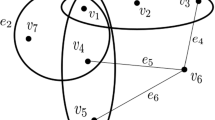Abstract
The purpose of this paper is to introduce a novel notion of hypergraph-based codes, L.C-hypergraphs and codeable hypergraphs with respect to binary (linear) codes. In order to realize the article’s goals, we define the concepts of code-based graphs, consider them as complex networks and construct them from binary (linear) codes via an equivalence relation on (L.C-hypergraphs) codeable hypergraphs. The paper includes implications for the development of fuzzy graph and for modeling the security problems by codeable hypergraphs and applications in complex hypernetworks. The new conception of codeable hypergraphs was given for the first time in this paper. Finally (L.C-hypergraphs), codeable hypergraphs, as complex hypernetworks, are applied as a tool in wireless sensor hypernetworks, code-based graphs, in wireless sensor networks and the bilateral relations between them.



















Similar content being viewed by others
Explore related subjects
Discover the latest articles, news and stories from top researchers in related subjects.References
Barg A, Mazumdar A, Zémor G (2008) Weight distribution and decoding of codes on hypergraphs. Adv Math Commun 18(2):433–450
Berge C (1979) Graphs and hypergraphs. North Holland
Bilua O, Hooryb S (2004) On codes from hypergraphs. Eur J Combin 25:339–354
Bocacich P, Holdren AC, Johnston M (2004) Hyperedges and multidimensional centrality. Soc. Netw. 26(3):189–203
Bretto A (2013) Applications of hypergraph theory, a brief overview, hypergraph theory. Springer, New York, pp 111–116
Corsini P, Leoreanu V (2003) Applications of hyperstructure theory. Kluwer Academical Publications, Dordrecht
Estradaa E, Velazquez JAR (2006) Subgraph centrality and clustering in complex hyper-networks. Phys A 364:581–594
Hamidi M, Borumand Saeid A (2019a) On derivable trees. Trans Comb 8(2):21–43
Hamidi M, Borumand Saeid A (2019b) Creating and computing graphs from hypergraphs. Kragujev J Math 43(1):139–164
Hamidi M, Borumand Saied A (2018a) Accessible single-valued neutrosophic graphs. J Appl Math Comput 57:121–146
Hamidi M, Borumand Saied A (2018b) Achievable single-valued neutrosophic graphs in wireless sensor networks. New Math Nat Comput 14(2):157–185
Hamidi M, Borumand Saied A (2018c) Accessible hypergraphs from BCH codes. In: Proceedings of the 6th Iranian Joint Congress on Fuzzy and Intelligent Systems (CFIS), IEEE
Hwang Y, Heo J (2016) On the relation between a graph code and a graph state. Quant Inf Comput 16(3 & 4):237–250
Khandekar A (2002) Graph-based codes and iterative decoding. California Institute of Technology Pasadena, California
Kotropoulos C (2016) Multimedia social search based on hypergraph learning. In: Pitas I (ed) Graph based social media analysis. CRC Press, Boca Raton, FL, pp 215–273
Ling S, Xing C (2004) Coding theory a first course. United States of America by Cambridge University Press, New York
Liu M, Zhang J, Yap P, Shen D (2017) View-aligned hypergraph learning for Alzheimers disease diagnosis with incomplete multimodality data. Med Image Anal 36:123–134
Molnar B (2014) Applications of hypergraphs in informatics a survey and opportunities for research. Ann Univ Sci Budapest Sect Comp 42:261–282
Najafi A, Borumand Saeid A (2019) Fuzzy points in \(BB\)-algebras. J Mahani Math Res Center 8(1–2):69–80
Pu L, Faltings B (2012) Hypergraph learning with hyperedge expansion. Joint Eur Conf Mach Learn Knowl Discov Databases 410–425
Shangguan C, Zhang Y, Ge G (2018) Centralized coded caching schemes: a hypergraph theoretical approach. IEEE Trans Inform Theory 64(8):5755–5766
Sole P, Zaslavsky T (1994) The covering radius of the cycle code of a graph. Disc Math 128:401–405
Tallini G (1985) On Steiner hyper groups and Linear codes. Altre Strutture multivoche e loro applicazioni, Udine, Convegno Ipergruppi, pp 87–91
Tsuda K (2005) Propagating distributions on a hypergraph by dual information regularization. In: Proceedings of the 22th international conference on machine learning
Urquidi JMP (2010) Expander graphs and error correcting codes, Universite de Bordeaux 1 Sciences et Technologies U.F.R. Math ematiques et Informatique
Zhao W, Tan S, Guan Z, Zhang B, Gong M, Cao Z, Wang Q (2018) Learning to map social network users by unified manifold alignment on hypergraph. IEEE Trans Neural Netw Learn Syst 29(12):5834–5846
Zhou S (2016) Total perfect codes in Cayley graphs. Des Codes Cryptogr 81:489–504
Zhu L, Shen J, Xie L, Cheng Z (2017) Unsupervised topic hypergraph hashing for efficient mobile image retrieval. IEEE Trans Cybern 47(11):3941–3954
Acknowledgements
We wish to thank the reviewers for excellent suggestions that have been incorporated into the paper.
Author information
Authors and Affiliations
Corresponding author
Ethics declarations
Conflict of Interest
Authors declare that they have no conflict of interest.
Human and animal rights
This article does not contain any studies with human participants or animals performed by any of the authors.
Additional information
Publisher's Note
Springer Nature remains neutral with regard to jurisdictional claims in published maps and institutional affiliations.
Rights and permissions
About this article
Cite this article
Hamidi, M., Saeid, A.B. Secreted graphs to binary codes and applications. Soft Comput 26, 5025–5042 (2022). https://doi.org/10.1007/s00500-022-06948-6
Accepted:
Published:
Issue Date:
DOI: https://doi.org/10.1007/s00500-022-06948-6




